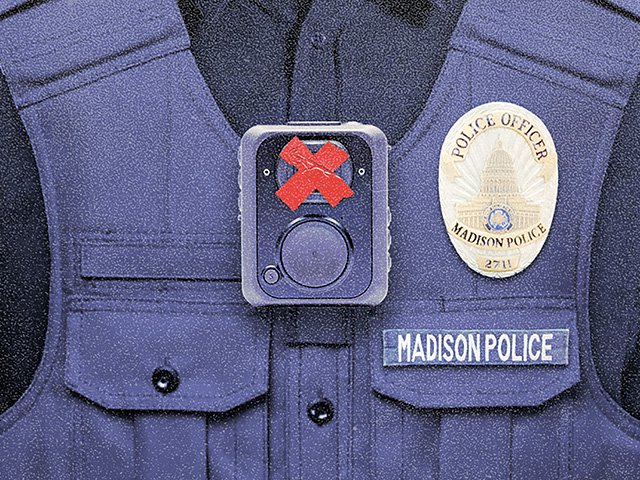After Mike Brown was killed in 2014 by police in Ferguson, Missouri, there was a collective call to outfit the nation’s police officers with body-worn cameras. Many, including myself, thought this would create more transparency and accountability and potentially reduce the use of force by police departments.
But I no longer think they are worth the investment.
I have grown increasingly skeptical when I hear police arguing for cameras on the basis of accountability and transparency. When have police willingly embraced transparency and accountability? Supporters also argue for the cameras as an additional surveillance tool to aid investigations and prosecutions. But is investing in yet another tool of policing a solution to our social ills?
The Madison city council has been debating the issue for several years now and most recently revived efforts to implement a pilot program to outfit officers in the North Police District with body cams. Police Chief Shon Barnes is a supporter, and the department has recently hosted several information sessions for the public.
I have done a lot of reading on the topic, and most comprehensive studies have found that body-worn cameras do not reduce the use of force. A 2017 randomized controlled trial by The Lab@DC, an arm of the District of Columbia government, involved 2,224 city police officers. It found no statistically significant impact of body-worn cameras on the use of force.
Another large review of the literature on body-worn cameras done by criminologists out of George Mason University came to a similar conclusion. The researchers looked at 70 empirical studies “covering the impact of cameras on officer behavior, officer perceptions, citizen behavior, citizen perceptions, police investigations, and police organizations.” They found that “In total, these study findings do not reveal a definitive conclusion that BWCs can reduce officers’ use of force.”
Why trust these studies? They use large sample sizes and this increases reliability. They are randomized control trials, peer-reviewed and can be replicated.
The few studies showing a reduction in the use of force do not hold up well under scrutiny. The 2012 Rialto study (named for the officers in Rialto, California, who were part of the yearlong study) is perhaps most often quoted. But there are questions about its reliability — it included only 54 officers, was not a randomized controlled trial, and did not receive any independent evaluation before publication.
Some studies that argue body-worn cameras reduce the use of force don’t even track a reduction in the use of force but use a decrease in complaints as evidence of effectiveness, including a 2018 report from the Police Executive Research Forum.
Another argument against body cams: What shows up in video footage depends often on the angle at which it is taken; police body-cam footage can look very different from bystander footage. The same scene can either look like a person is dancing, or, when taken from a body-worn camera, fighting an officer.
Some supporters point to the conviction of Derek Chauvin for the murder of George Floyd as evidence that body cameras for police work. But in hundreds of other confrontations caught on video, including the police killings of Tamir Rice and Eric Garner, nothing happened to the officers.
Chauvin had multiple complaints against him before he killed Floyd. The problem we have is not the lack of video evidence; it is in holding officers accountable for misconduct. The bar for prosecutors to hold police legally accountable for their actions is remarkably high. Keep in mind a forensic report in Madison showed Madison police officer Matt Kenny lied about what transpired the night he killed Tony Robinson in 2015, and Kenny is still on the police force.
Since then, the Police Department’s track record on transparency has not gotten better. On Oct. 10, a Madison police officer shot another officer chasing a suspect on foot. Initially, the department implied that the suspect shot the officer; it took about a week for the department to correct the record. And in late November, Madison Police Chief Barnes threatened to fire any officer who would leak information about the resignation of an officer caught having sex in his squad car in August 2021; firing an officer is up to the Police and Fire Commission, not the police chief. And there were weeks of silence from multiple law enforcement agencies after the shooting of Quadren Wilson by two officers in the Department of Justice’s Division of Criminal Investigation.
Had these police officers been wearing body cams, would administrators have been any more transparent about what transpired? Highly doubtful.
Body-worn cameras also aren’t cheap. It has been estimated that it would cost nearly $1.5 million in startup costs and $376,000 annually to outfit the entire Madison police force; funding for the pilot program was allocated in the 2021 city budget at $83,000.
The debate over body-worn cameras is as much about our worldview and spending priorities as anything else. State and local governments in the United States spend more collectively on policing than most countries spend on their militaries. And we spend that at the expense of policies and initiatives that lift up people. We need to acknowledge that the most policed and incarcerated nation in the world is not the safest. And then ask ourselves, is there a better way?
Matthew Braunginn is a civil rights advocate, policy researcher, and writer.


